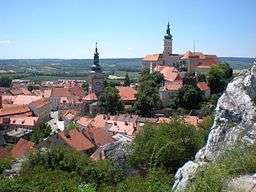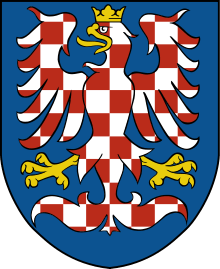Moravia
| Moravia Morava | |||
|---|---|---|---|
| Historical land | |||
|
The town of Mikulov | |||
| |||
|
Anthem: Various Predominantly "Jsem Moravan" or "Moravo, Moravo"[1] | |||
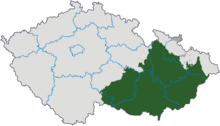 Moravia (green) in relation to the current regions of the Czech Republic | |||
 Location of Moravia in the European Union | |||
| Coordinates: 49°30′N 17°00′E / 49.5°N 17°ECoordinates: 49°30′N 17°00′E / 49.5°N 17°E | |||
| Country |
| ||
| Regions | Moravian-Silesian Region, Olomouc Region, South Moravian Region, Vysočina, Zlín Region | ||
| First mentioned | 822[2][3] | ||
| Consolidated | 833[4] | ||
| Former capital |
Brno (1641-1948)[5] Brno, Olomouc (until 1641) | ||
| Major cities | Brno, Ostrava, Olomouc, Zlín, Jihlava | ||
| Area | |||
| • Total | 22,348.87 km2 (8,628.95 sq mi) | ||
| Population | |||
| • Total | 3,100,000[6] | ||
| Demonym(s) | Moravian | ||
| Time zone | CET (UTC+1) | ||
| • Summer (DST) | CEST (UTC+2) | ||
Moravia (Czech: Morava; German: ![]() Mähren ; Polish: Morawy; Latin: Moravia) is a historical country in the Czech Republic (forming its eastern part) and one of the historical Czech lands, together with Bohemia and Czech Silesia. The medieval and early modern Margraviate of Moravia was a crown land of the Lands of the Bohemian Crown (from 1348 to 1918), an imperial state of the Holy Roman Empire (1004 to 1806), later a crown land of the Austrian Empire (1804 to 1867) and briefly also one of 17 former crown lands of the Cisleithanian part of the Austro-Hungarian Empire from 1867 to 1918. During the early 20th century, Moravia was one of the five lands of Czechoslovakia from 1918 to 1928; it was then merged with Czech Silesia, and eventually dissolved by abolition of the land system in 1949.
Mähren ; Polish: Morawy; Latin: Moravia) is a historical country in the Czech Republic (forming its eastern part) and one of the historical Czech lands, together with Bohemia and Czech Silesia. The medieval and early modern Margraviate of Moravia was a crown land of the Lands of the Bohemian Crown (from 1348 to 1918), an imperial state of the Holy Roman Empire (1004 to 1806), later a crown land of the Austrian Empire (1804 to 1867) and briefly also one of 17 former crown lands of the Cisleithanian part of the Austro-Hungarian Empire from 1867 to 1918. During the early 20th century, Moravia was one of the five lands of Czechoslovakia from 1918 to 1928; it was then merged with Czech Silesia, and eventually dissolved by abolition of the land system in 1949.
Moravia has an area of over 22 348,87 km2[7] and about 3 million inhabitants, which is roughly 2/7 or 30% of the whole Czech Republic. The statistics from 1921 states, that the whole area of Moravia including the enclaves in Silesia covers 22623,41 km2.[8][9] The people are historically named Moravians, a subgroup of Czechs (as understood by Czechs). The land takes its name from the Morava river, which rises in the northern tip of the region and flows southward to the opposite end, being its major stream. Moravia's largest city and historical capital is Brno, however before being sacked by the Swedish army during the Thirty Years' War, Olomouc was another capital.[5]
Though officially abolished by an administrative reform in 1949, Moravia is still commonly acknowledged as a specific land in the Czech Republic. Moravian people are considerably aware of their Moravian identity and there is some rivalry between them and the Czechs from Bohemia.[10][11]
Geography


Moravia occupies most of the eastern part of the Czech Republic. Moravian territory is naturally strongly determined, in fact, as the Morava river basin, with strong effect of mountains in the west (de facto main European continental divide) and partly in the east, where all the rivers rises.
Moravia occupies an exceptional position in Central Europe. All the highlands in the west and east of this part of Europe run west-east, and therefore form a kind of filter, making north-south or south north movement more difficult. Only Moravia with the depression of the westernmost Subcarpathia, 14–40 kilometers (8.7–24.9 mi) wide, between the Bohemian Massif and the Outer Western Carpathians (gripping the meridian at a constant angle of 30°), provides a comfortable connection between the Danubian and Polish regions, and this area is thus of great importance in terms of the possible migration routes of large mammals[14] – both as regards periodically recurring seasonal migrations triggered by climatic oscillations in the prehistory, when permanent settlement started.
Moravia borders Bohemia in the west, Lower Austria in the south(west), Slovakia in the southeast, Poland very shortly in the north, and Czech Silesia in the northeast. Its natural boundary is formed by the Sudetes mountains in the north, the Carpathians in the east and the Bohemian-Moravian Highlands in the west (the border runs from Králický Sněžník in the north, over Suchý vrch, across Upper Svratka Highlands and Javořice Highlands to tripoint nearby Slavonice in the south). The Thaya river meanders along the border with Austria and the tripoint of Moravia, Austria and Slovakia is at the confluence of the Thaya and Morava rivers. The northeast border with Silesia runs partly along the Moravice, Oder and Ostravice rivers. Between 1782–1850, Moravia (also thus known as Moravia-Silesia) also included a small portion of the former province of Silesia – the Austrian Silesia (when Frederick the Great annexed most of ancient Silesia (the land of upper and middle Oder river) to Prussia, Silesia's southernmost part remained with the Habsburgs).
Today Moravia including the South Moravian Region,[15] the Zlín Region, vast majority of the Olomouc Region, southeastern half of the Vysočina Region and parts of the Moravian-Silesian, Pardubice and South Bohemian regions.
Geologically, Moravia covers a transitive area between the Bohemian Massif and the Carpathians (from (north)west to southeast), and between the Danube basin and the North European Plain (from south to northeast). Its core geomorphological features are three wide vales (Czech: úval), namely the Dyje-Svratka Vale (Dyjsko-svratecký úval), the Upper Morava Vale (Hornomoravský úval) and the Lower Morava Vale (Dolnomoravský úval). The former two form the westernmost part of the Subcarpathia, the latter one is the northernmost part of the Vienna Basin. The vales surround the low range of Central Moravian Carpathians. The highest mountains of Moravia are situated on its northern border in Hrubý Jeseník, the highest peak is Praděd (1490 m). Second highest are the Moravian-Silesian Beskids at the very east, with Smrk (1278 m), and then south from here Javorníky (1072). The White Carpathians along the southeastern border rise up to 970 m at Velká Javořina. The spacious, but moderate Bohemian-Moravian Highlands on the west reach 837 m at Devět skal.
The fluvial system of Moravia is very cohesive, as the region border is similar to the watershed of the Morava river, and thus almost the entire area is drained exclusively by a single stream. Morava's far biggest tributaries are Thaya (Dyje) from the right (or west) and Bečva (east). Morava and Thaya meet at the southernmost and lowest (148 m) point of Moravia. Small peripheral parts of Moravia belong to the catchment area of Elbe, Váh and especially Oder (the northeast). The watershed line running along Moravia's border from west to north and east is part of the European Watershed. For centuries, there has been plans to build a waterway across Moravia to join the Danube and Oder river systems, using the natural route through the Moravian Gate.[16][17]
Pre-history

Evidence of the presence of Homo dates back more than 600,000 years in the paleontological area of Stránská Skála.[14]
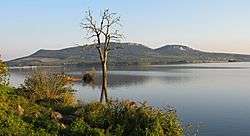
Attracted by suitable living conditions, early modern humans settled in the region by the Paleolithic period. The Předmostí archeological (Cro-magnon) site in Moravia is dated to between 24,000 and 27,000 years old.[18][19] Caves in Moravský kras were used by mammoth hunters. Venus of Dolní Věstonice, the oldest ceramic figure in the world,[20][21] was found in the excavation of Dolní Věstonice by Karel Absolon.[22]
History
Roman era
Around 60 BC, the Celtic Volcae people withdrew from the region and were succeeded by the Germanic Quadi. Some of the events of the Marcomannic Wars took place in Moravia in AD 169–180. After the war exposed the weakness of Rome's northern frontier, half of the Roman legions (16 out of 33) were stationed along the Danube. In response to increasing numbers of Germanic settlers in frontier regions like Pannonia, Dacia, Rome established two new frontier provinces on the left shore of the Danube, Marcomannia and Sarmatia, including today's Moravia and western Slovakia.
In the 2nd century AD, a Roman fortress[23][24] stood on the vineyards hill known as German: Burgstall and Czech: Hradisko ("hillfort"), situated above the former village Mušov and above today's beach resort at Pasohlávky. During the reign of the Emperor Marcus Aurelius, the 10th Legion was assigned to control the Germanic tribes who had been defeated in the Marcomannic Wars.[25] In 1927, the archeologist Gnirs, with the support of president Tomáš Garrigue Masaryk, began research on the site, located 80 km far from Vindobona and 22 km to the south from Brno. The researchers found remnants of two masonry buildings, a praetorium[26] and a balneum ("bath"), including a hypocaustum. The discovery of bricks with the stamp of the Legio X Gemina and coins from the period of the emperors Antoninus Pius, Marcus Aurelius and Commodus facilitated dating of the locality.
Ancient Moravia

A variety of Germanic and major Slavic tribes crossed through Moravia during the Migration Period before Slavs established themselves in the 6th century AD. At the end of the 8th century, the Moravian Principality came into being in present-day south-eastern Moravia, Záhorie in south-western Slovakia and parts of Lower Austria. In 833 AD, this became the state of Great Moravia[27] with the conquest of the Principality of Nitra (present-day Slovakia). Their first king was Mojmír I (ruled 830–846). Louis the German invaded Moravia and replaced Mojmír I with his nephew Rastiz who became St. Rastislav.[28] St. Rastislav (846–870) tried to emancipate his land from the Carolingian influence, so he sent envoys to Rome to get missionaries to come. When Rome refused he turned to Constantinople to the Byzantine emperor Michael. The result was the mission of Saints Cyril and Methodius who translated liturgical books into Slavonic, which had lately been elevated by the Pope to the same level as Latin and Greek. Methodius became the first Moravian archbishop, but after his death the German influence again prevailed and the disciples of Methodius were forced to flee. Great Moravia reached its greatest territorial extent in the 890s under Svatopluk I. At this time, the empire encompassed the territory of the present-day Czech Republic and Slovakia, the western part of present Hungary (Pannonia), as well as Lusatia in present-day Germany and Silesia and the upper Vistula basin in southern Poland. After Svatopluk's death in 895, the Bohemian princes defected to become vassals of the East Frankish ruler Arnulf of Carinthia, and the Moravian state ceased to exist after being overrun by invading Magyars in 907.[29][30]
Union with Bohemia

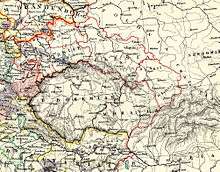

Following the defeat of the Magyars by Emperor Otto I at the Battle of Lechfeld in 955, Otto's ally Boleslaus I, the Přemyslid ruler of Bohemia, took control over Moravia. Bolesław I Chrobry of Poland annexed Moravia in 999, and ruled it until 1019,[31] when the Přemyslid prince Bretislaus recaptured it. Upon his father's death in 1034, Bretislaus became the ruler of Bohemia. In 1055, he decreed that Bohemia and Moravia would be inherited together by primogeniture, although he also provided that his younger sons should govern parts (quarters) of Moravia as vassals to his oldest son.
Throughout the Přemyslid era, junior princes often ruled all or part of Moravia from Olomouc, Brno or Znojmo, with varying degrees of autonomy from the ruler of Bohemia. Dukes of Olomouc often acted as the "right hand" of Prague dukes and kings, while Dukes of Brno and especially those of Znojmo were much more insubordinate. Moravia reached its height of autonomy in 1182, when Emperor Frederick I elevated Conrad II Otto of Znojmo to the status of a margrave,[32] immediately subject to the emperor, independent of Bohemia. This status was short-lived: in 1186, Conrad Otto was forced to obey the supreme rule of Bohemian duke Frederick. Three years later, Conrad Otto succeeded to Frederick as Duke of Bohemia and subsequently canceled his margrave title. Nevertheless, the margrave title was restored in 1197 when Vladislaus III of Bohemia resolved the succession dispute between him and his brother Ottokar by abdicating from the Bohemian throne and accepting Moravia as a vassal land of Bohemian (i.e., Prague) rulers. Vladislaus gradually established this land as Margraviate, slightly administratively different from Bohemia. After the Battle of Legnica, the Mongols carried their raids into Moravia.
The main line of the Přemyslid dynasty became extinct in 1306, and in 1310 John of Luxembourg became Margrave of Moravia and King of Bohemia. In 1333, he made his son Charles the next Margrave of Moravia (later in 1346, Charles become also the King of Bohemia). In 1349, Charles gave Moravia to his younger brother John Henry who ruled in the margraviate until his death in 1375, after him Moravia was ruled by his oldest son Jobst of Moravia who was in 1410 elected the Holy Roman King but died in 1411 (he is buried with his father in the Church of St. Thomas in Brno – the Moravian capital from which they both ruled). Moravia and Bohemia remained within the Luxembourg dynasty of Holy Roman kings and emperors (except during the Hussite wars), until inherited by Albert II of Habsburg in 1437.
After his death followed the interregnum until 1453; land (as the rest of lands of the Bohemian Crown) was administered by the landfriedens (landfrýdy). The rule of young Ladislaus the Posthumous subsisted only less than five years and subsequently (1458) the Hussite George of Poděbrady was elected as the king. He again reunited all Czech lands (then Bohemia, Moravia, Silesia, Upper & Lower Lusatia) into one-man ruled state. In 1466, Pope Paul II excommunicated George and forbade all Catholics (i.e. about 15% of population) from continuing to serve him. The Hungarian crusade followed and in 1469 Matthias Corvinus conquered Moravia and proclaimed himself (with assistance of rebelling Bohemian nobility) as the king of Bohemia.
The subsequent 21-year period of a divided kingdom was decisive for the rising awareness of a specific Moravian identity, distinct from that of Bohemia. Although Moravia was reunited with Bohemia in 1490 when Vladislaus Jagiellon, king of Bohemia, also became king of Hungary, some attachment to Moravian "freedoms" and resistance to government by Prague continued until the end of independence in 1620. In 1526, Vladislaus' son Louis died in battle and the Habsburg Ferdinand I was elected as his successor.
Habsburg rule (1526–1918)

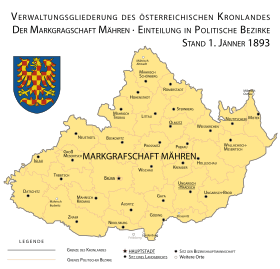
The epoch 1526–1620 was marked by increasing animosity between Catholic Habsburg kings (emperors) and the Protestant Moravian nobility (and other Crowns') estates. Moravia,[33] like Bohemia, was a Habsburg possession until the end of World War I. In 1573 the Jesuit University of Olomouc was established; this was the first university in Moravia. The establishment of a special papal seminary, Collegium Nordicum, made the University a centre of the Catholic Reformation and effort to revive Catholicism in Central and Northern Europe. The second largest group of students were from Scandinavia.
Brno and Olomouc served as Moravia's capitals until 1641. As the only city to successfully resist the Swedish invasion, Brno become the sole capital following the capture of Olomouc. The Margraviate of Moravia had, from 1348 in Olomouc and Brno, its own Diet, or parliament, zemský sněm (Landtag in German), whose deputies from 1905 onward were elected separately from the ethnically separate German and Czech constituencies.
The oldest surviving theatre building in Central Europe, the Reduta Theatre, was established in 17th-century Moravia. Ottoman Turks and Tatars invaded the region in 1663, taking 12,000 captives.[34] In 1740, Moravia was invaded by Prussian forces under Frederick the Great, and Olomouc was forced to surrender on 27 December 1741. A few months later the Prussians were repelled, mainly because of their unsuccessful siege of Brno in 1742. In 1758, Olomouc was besieged by Prussians again, but this time its defenders forced the Prussians to withdraw following the Battle of Domstadtl. In 1777, a new Moravian bishopric was established in Brno, and the Olomouc bishopric was elevated to an archbishopric.[35] In 1782, the Margaviate of Moravia was merged with Austrian Silesia into Moravia-Silesia, with Brno as its capital. This lasted until 1850.[36]
20th century

Following the break-up of the Austro-Hungarian Empire in 1918, Moravia became part of Czechoslovakia. As one of the five lands of Czechoslovakia, it had restricted autonomy. In 1928 Moravia ceased to exist as a territorial unity and was merged with Czech Silesia into the Moravian-Silesian Land (yet with the natural dominance of Moravia). By the Munich Agreement (1938) were southwestern and northern peripheries of Moravia annexed by Nazi Germany, and during the German occupation of Czechoslovakia (1939–1945), the remnant of Moravia was an administrative unit within the Protectorate of Bohemia and Moravia.
In 1945 after the end of World War II and Allied defeat of Germany, Czechoslovakia expelled the ethnic German minority of Moravia to Germany and Austria. The Moravian-Silesian Land was restored with Moravia as part of it. In 1949 the territorial division of Czechoslovakia was radically changed, as the Moravian-Silesian Land was abolished and Lands were replaced by "kraje" (regions), whose borders substantially differ from the historical Bohemian-Moravian border, so Moravia politically ceased to exist after more than 1100 years (833–1949) of its history. Although another administrative reform in 1960 implemented (among others) the North Moravian and the South Moravian regions (Severomoravský and Jihomoravský kraj), with capitals in Ostrava and Brno respectively, their joint area was only roughly alike the historical state and, chiefly, there was no land or federal autonomy, unlike Slovakia.
After the fall of the Soviet Union and the whole Eastern Block, the Czechoslovak Federal Assembly condemned the cancellation of Moravian-Silesian land and expressed "firm conviction that this injustice will be corrected" in 1990. However, after the breakup of Czechoslovakia into Czech Republic and Slovakia in 1993, Moravian area remained integral to the Czech territory, and the latest administrative division of Czech Republic (introduced in 2000) is similar to the administrative division of 1949. Nevertheless, the federalist or separatist movement in Moravia is completely marginal.
The centuries-lasting historical Bohemian-Moravian border has been preserved up to now only by the Czech Roman Catholic Administration, as the Ecclesiastical Province of Moravia corresponds with the former Moravian-Silesian Land. The popular perception of the Bohemian-Moravian border's location is distorted by the memory of the 1960 regions (whose boundaries are still partly in use).
Gallery
 General map of Moravia 1929
General map of Moravia 1929 Moravia within Czechoslovakia between 1918–1928
Moravia within Czechoslovakia between 1918–1928 Moravia as part of the Moravia-Silesia within Czechoslovakia between 1928–1938
Moravia as part of the Moravia-Silesia within Czechoslovakia between 1928–1938 Moravia-Silesia within Czechoslovakia between 1928–1938
Moravia-Silesia within Czechoslovakia between 1928–1938 Moravia within the Czech Republic
Moravia within the Czech Republic- Moravian nationality, as declared by people in the 1991 census
- Řeznovice Romanesque temple S. Peter and Paul


Economy
An area in South Moravia, around Hodonín and Břeclav, is part of the Viennese Basin. Petroleum and lignite are found there in abundance. The main economic centres of Moravia are Brno, Olomouc and Zlín, plus Ostrava lying directly on the Moravian-Silesian border. As well as agriculture in general, Moravia is noted for its viticulture; it contains 94% of the Czech Republic's vineyards and is at the centre of the country's wine industry.
- Oldest Iron Blast furnace near Brno, 1745
 Thonet chair No. 14
Thonet chair No. 14 Wikow 35, first aerodynamics car in Czechoslovakia
Wikow 35, first aerodynamics car in Czechoslovakia
 Zetor tractor
Zetor tractor
.jpg)
Arms industry
Moravia is also the centre of the Czech firearm industry, as the vast majority of Czech firearms manufacturers (e.g. CZUB, Zbrojovka Brno, Czech Small Arms, Czech Weapons, ZVI, Great Gun) are settled in Moravia. Almost all well-known Czech sporting, self-defence, military and hunting firearms come from Moravia. Also, Meopta rifle scopes are of Moravian origin.
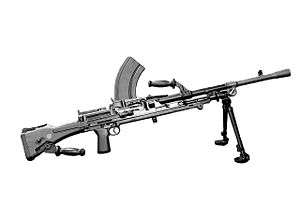
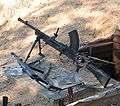 Famous original Bren gun in field
Famous original Bren gun in field Moravian assault rifle CZ-805 BREN
Moravian assault rifle CZ-805 BREN Moravian assault rifle Sa vz. 58
Moravian assault rifle Sa vz. 58 Moravian handgun CZ 75
Moravian handgun CZ 75 Moravian handgun ZVI Kevin, a.k.a. Micro Desert Eagle
Moravian handgun ZVI Kevin, a.k.a. Micro Desert Eagle
Aircraft industry
The Zlín Region hosts several aircraft manufacturers, namely Let Kunovice (also known as Aircraft Industries, a.s.), ZLIN AIRCRAFT a.s. Otrokovice (former well-known name Moravan Otrokovice), Evektor-Aerotechnik and Czech Sport Aircraft. Sport aircraft are also manufactured in Jihlava by Jihlavan Airplanes/Skyleader.
Aircraft production in the region started in 1930s and there are signs of recovery in recent years and the production is expected to grow from 2013 onwards.[37]
.jpg) Moravian aircraft Zlín Z-50
Moravian aircraft Zlín Z-50 Tatra aircraft (licensed)
Tatra aircraft (licensed) Moravian aircraft Zlín Z-50
Moravian aircraft Zlín Z-50.jpg) Moravian aircraft Let L-200 Morava
Moravian aircraft Let L-200 Morava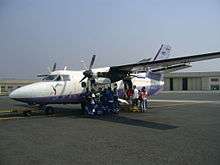 Moravian aircraft Let L-410
Moravian aircraft Let L-410 Moravian aircraft Evektor EV-55 Outback
Moravian aircraft Evektor EV-55 Outback Moravian aircraft Jihlavan KP-2U Skyleader
Moravian aircraft Jihlavan KP-2U Skyleader
Machinery industry
Machinery has been the most important industrial sector in the region, especially in South Moravia, for many decades. The main centres of machinery production are Brno (Zbrojovka Brno, Zetor, První brněnská strojírna, Siemens), Blansko (ČKD Blansko, Metra), Adamov (ADAST), Kuřim (TOS Kuřim), Boskovice (Minerva, Novibra) and Břeclav (Otis Elevator Company), together with a large number of other variously sized machinery or machining factories, companies or workshops spread all over Moravia.
Electrical industry
The beginnings of the electrical industry in Moravia date back to 1918. The biggest centres of electrical production are Brno (VUES, ZPA Brno, EM Brno), Drásov, Frenštát pod Radhoštěm and Mohelnice (currently Siemens).
Cities
Statutory cities
- Brno, ca 380,000 inhabitants, former land capital and nowadays capital of South Moravian Region; industrial, judicial, educational and research centre; railway and motorway junction
- Ostrava, ca 300,000 inh. (central part, Moravská Ostrava, lies historically in Moravia, most of the outskirts are in Czech Silesia), capital of Moravian-Silesian Region, centre of heavy industry
- Olomouc, ca 100,000 inh., capital of Olomouc Region, medieval land capital, seat of Roman Catholic archbishop, cultural centre of Hanakia and Central Moravia
- Zlín, ca 75,000 inh., capital of Zlín Region, modern city developed after First World War by the Bata Shoes company
- Frýdek-Místek, nearly 60,000 inh., twin-town lying directly on the old Moravian-Silesian border (the western part, Místek, is Moravian), in the industrial area around Ostrava
- Jihlava, ca 50,000 inh. (mostly in Moravia, northwestern periphery lies in Bohemia), capital of Vysočina Region, centre of the Moravian Highlands
- Přerov, ca 45,000 inh., important railway hub and archaeological site (Předmostí)
Other cities
- Prostějov (44,000 inh.), centre of clothing and fashion industry
- Třebíč (37,000), another centre in the Highlands, with exceptionally preserved Jewish quarter
- Znojmo (34,000), historical and cultural centre of southwestern Moravia
- Kroměříž (29,000), historical city in southern Hanakia
- Valašské Meziříčí (28,000), largest city of the Moravian Wallachia
- Nový Jičín (28,000), historical city with hatting industry
- Šumperk (27,000), centre of the north of Moravia, at the foot of Hrubý Jeseník
- Vsetín (27,000), centre of the Moravian Wallachia
- Uherské Hradiště (25,000), cultural centre of the Moravian Slovakia
- Hodonín (25,000), another city in the Moravian Slovakia, the birthplace of Tomáš Garrigue Masaryk
- Břeclav (25,000), important railway hub in the very south of Moravia
- Kopřivnice (24,000), centre of automotive industry (Tatra), south from Ostrava
- Vyškov (21,000), local centre at a motorway junction halfway between Brno and Olomouc
- Blansko (21,000), industrial city north from Brno, at the foot of the Moravian Karst
People
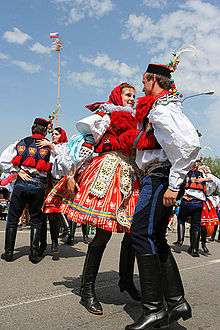
The Moravians are generally a Slavic ethnic group who speak various (generally more archaic) dialects of Czech. Before the expulsion of Germans from Moravia the Moravian German minority also referred to themselves as "Moravians" (Mährer). Those expelled and their descendants continue to identify as Moravian. [38] Some Moravians assert that Moravian is a language distinct from Czech; however, their position is not widely supported by academics and the public.[39][40][41][42] Some Moravians identify as an ethnically distinct group; the majority consider themselves to be ethnically Czech. In the census of 1991 (the first census in history in which respondents were allowed to claim Moravian nationality), 1,362,000 (13.2%) of the Czech population identified as being of Moravian nationality (or ethnicity). In the census of 2001, this number had decreased to 380,000 (3.7% of the population).[43] In the census of 2011, this number rose to 522,474 (4.9% of the Czech population).[44][45]
| Historical population | ||
|---|---|---|
| Year | Pop. | ±% |
| 9th c. | 500,000 | — |
| 13th c. | 580,000 | +16.0% |
| 15th c. | 650,000 | +12.1% |
| 1775 | 1,134,674 | +74.6% |
| 1800 | 1,656,397 | +46.0% |
| 1810 | 1,346,802 | −18.7% |
| 1820 | 1,443,804 | +7.2% |
| 1830 | 1,643,637 | +13.8% |
| 1840 | 1,703,995 | +3.7% |
| 1850 | 1,793,674 | +5.3% |
| 1878 | 2,103,847 | +17.3% |
| 1880 | 2,160,471 | +2.7% |
| 1890 | 2,285,321 | +5.8% |
| 1900 | 2,447,121 | +7.1% |
| 1910 | 2,693,027 | +10.0% |
| 1921 | 2,662,884 | −1.1% |
| 1930 | 2,827,648 | +6.2% |
| 1950 | 2,610,650 | −7.7% |
| Source: Růžková, J., Josef Škrabal, J.; et al. (2006). Historický lexikon obcí České republiky 1869–2005 [Historical lexicon of municipalities in the Czech Republic 1869–2005] (PDF) (in Czech). Díl I. Český statistický úřad. pp. 51–54. ISBN 80-250-1311-1. | ||
Moravia historically had a large minority of ethnic Germans, some of whom had arrived as early as the 13th century at the behest of the Přemyslid dynasty. Germans continued to come to Moravia in waves, culminating in the 18th century. They lived in the main city centres and in the countryside along the border with Austria (stretching up to Brno) and along the border with Silesia at Jeseníky, and also in two language islands, around Jihlava and around Moravská Třebová. After the Second World War, Czechoslovakia almost fully expelled them in retaliation for Nazi German efforts to create a Greater Germanic Reich in Central Europe.
Moravians
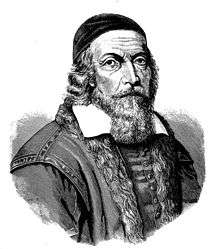 Comenius
Comenius Gregor Mendel
Gregor Mendel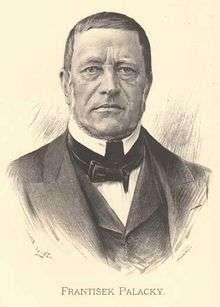 František Palacký
František Palacký Jaromír Mundy
Jaromír Mundy- Tomáš Garrigue Masaryk
 Leoš Janáček
Leoš Janáček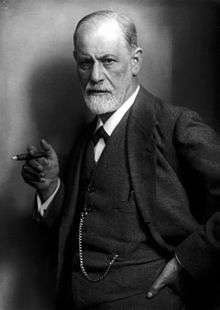 Sigmund Freud
Sigmund Freud Edmund Husserl
Edmund Husserl Alphonse Mucha
Alphonse Mucha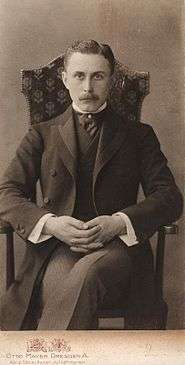 Adolf Loos
Adolf Loos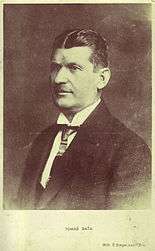 Tomáš Baťa
Tomáš Baťa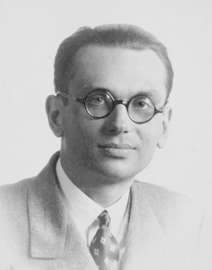 Kurt Gödel
Kurt Gödel Emil Zátopek
Emil Zátopek Milan Kundera
Milan Kundera Ivan Lendl
Ivan Lendl
Notable people from Moravia include (in order of birth):
- Anton Pilgram (1450–1516), architect, sculptor and woodcarver
- Jan Ámos Komenský (Comenius) (1592–1670), educator and theologian, last bishop of Unity of the Brethren
- David Zeisberger (1717–1807) Moravian missionary to the Leni Lenape, "Apostle to the Indians"
- Georgius Prochaska (1749–1820), ophthalmologist and physiologist
- František Palacký (1798–1876), historian and politician, "The Father of the Czech nation"
- Gregor Mendel (1822–1884), father of genetics
- Ernst Mach (1838–1916), physicist and philosopher
- Tomáš Garrigue Masaryk (1850–1937), philosopher and politician, first president of Czechoslovakia
- Leoš Janáček (1854–1928), composer
- Sigmund Freud (1856–1939), father of psychoanalysis
- Edmund Husserl (1859–1938), philosopher
- Alfons Mucha (1860–1939), painter
- Adolf Loos (1870–1933), architect, pioneer of functionalism
- Karl Renner (1870–1950), Austrian statesman, co-founder of Friends of Nature movement
- Tomáš Baťa (1876–1932), entrepreneur, founder of Bata Shoes company

- Joseph Schumpeter (1883–1950), economist and political scientist
- Marie Jeritza (1887-1982), celebrated soprano singer
- Ludvík Svoboda (1895–1979), general of I Czechoslovak Army Corps, seventh president of Czechoslovakia
- Klement Gottwald (1896–1953), first Czechoslovak communist president
- Erich Wolfgang Korngold (1897–1957), composer
- George Placzek (1905–1955), physicist, participant in Manhattan Project
- Kurt Gödel (1906–1978), theoretical mathematician
- Oskar Schindler (1908–1974), entrepreneur, saviour of almost 1,200 Jews during the WWII
- Jan Kubiš (1913–1942), paratrooper who assassinated Nazi despot R. Heydrich
- Bohumil Hrabal (1914–1997), writer
- Thomas J. Bata (1914–2008), entrepreneur, son of Tomáš Baťa and former head of the Bata shoe company
- Emil Zátopek (1922–2000), long-distance runner, multiple Olympic gold medalist
- Karel Reisz (1926–2002), filmmaker, pioneer of British Free Cinema movement
- Milan Kundera (1929–), writer
- Ivana Trump (1949–), socialite and business magnate
- Ivan Lendl (1959–), tennis player
- Jiří Šlégr (1971–), ice hockey player, member of the Triple Gold Club
- Bohuslav Sobotka (1971–), social-democratic politician, Czech Prime Minister since 2014
- Magdalena Kožená (1973–), mezzo-soprano
- Markéta Irglová (1988–), celebrated singer and Academy Awarded songwriter
- Adam Ondra (1993–), rock climber
Ethnographic regions
Moravia can be divided on dialectal and lore basis into several ethnographic regions of comparable significance. In this sense, it is more heterogenous than Bohemia. Significant parts of Moravia, usually those formerly inhabited by the German speakers, are dialectally indifferent, as they have been resettled by people from various Czech (and Slovak) regions.
The principal cultural regions of Moravia are:
- Hanakia (Haná) in the central and northern part
- Lachia (Lašsko) in the northeastern tip
- Moravian Highlands (Horácko) in the west
- Moravian Slovakia (Slovácko) in the southeast
- Moravian Wallachia (Valašsko) in the east
Places of interest


World Heritage Sites
- Gardens and Castle at Kroměříž
- Historic Centre of Telč
- Holy Trinity Column in Olomouc
- Jewish Quarter and St Procopius' Basilica in Třebíč
- Lednice-Valtice Cultural Landscape
- Pilgrimage Church of St John of Nepomuk at Zelená Hora
- Tugendhat Villa in Brno
Other
- Hranice Abyss, one of the deepest underwater caves in the world
See also
References
- ↑ https://www.youtube.com/watch?v=EhSuWZW937M
- ↑ Royal Frankish Annals (year 822), pp. 111-112.
- ↑ http://www.nasamorava.eu/fakta-o-morave.html
- ↑ Bowlus, Charles R. (2009). "Nitra: when did it become a part of the Moravian realm? Evidence in the Frankish sources". Early Medieval Europe. Oxford, UK: Blackwell Publishing Ltd. 17 (3): 311–328. doi:10.1111/j.1468-0254.2009.00279.x. Retrieved 2013-08-27.
- 1 2 http://encyklopedie.brna.cz/home-mmb/?acc=profil_udalosti&load=550
- ↑ http://ciselnik.artega.cz/kraje_pocet_obyvatel_hruba_mzda_nezamestnanost.php
- ↑ "Změny v rozloze obcí a okresů.". Statistický lexikon obcí v republice Československé - II. Země Moravskoslezská (in Czech). Praha. 1935. pp. 149 and 151.
- ↑ "Dodatek I. Přehled Moravy a Slezska podle žup". Statistický lexikon obcí v republice Československé. Morava a Slezsko (in Czech). Praha: Státní úřad statistický. 1924. p. 133.
- ↑ "Dodatek IV. Moravské enklávy ve Slezsku". Statistický lexikon obcí v republice Československé. Morava a Slezsko (in Czech). Praha: Státní úřad statistický. 1924. p. 138.
- ↑ http://archiv.ihned.cz/c1-784432-jsem-moravan
- ↑ http://tn.nova.cz/clanek/zpravy/domaci/rikate-ceske-republice-cechy-pro-moravaky-jste-ignorant.html
- ↑ Svoboda, Zbyšek; Fojtík, Pavel; Exner, Petr; Martykán, Jaroslav (2013). "Odborné vexilologické stanovisko k moravské vlajce" (PDF). Vexilologie. Zpravodaj České vexilologické společnosti, o.s. č. 169. Brno: Česká vexilologická společnost. pp. 3319, 3320.
- ↑ Pícha, František (2013). "Znaky a prapory v kronice Ottokara Štýrského" (PDF). Vexilologie. Zpravodaj České vexilologické společnosti, o.s. č. 169. Brno: Česká vexilologická společnost. pp. 3320–3324.
- 1 2 Antón, Mauricio; Galobart, Angel; Turner, Alan (May 2005). "Co-existence of scimitar-toothed cats, lions and hominins in the European Pleistocene. Implications of the post-cranial anatomy of Homotherium latidens (Owen) for comparative palaeoecology". Quaternary Science Reviews. Elsevier. 24 (10-11): 1287–1301. doi:10.1016/j.quascirev.2004.09.008. Retrieved 23 June 2016.
- ↑ Not only here for the beer: Moravia, the Czech Republic's wine region. The Guardian 2011
- ↑ http://www.d-o-l.cz/index.php/en/about-d-o-e-project
- ↑ Klimo, Emil; Hager, Herbert (2000). The Floodplain Forests in Europe: Current Situation and Perspectives (European Forest Institute research reports). Leiden: Brill. p. 48. ISBN 9789004119581.
- ↑ Velemínskáa, J., Brůžekb, J., Velemínskýd, P., Bigonia, L., Šefčákováe, A., Katinaf, F. (2008). "Variability of the Upper Palaeolithic skulls from Předmostí near Přerov (Czech Republic): Craniometric comparison with recent human standards". Homo. 59 (1): 1–26. doi:10.1016/j.jchb.2007.12.003. PMID 18242606.
- ↑ Viegas, Jennifer (7 October 2011). "Prehistoric dog found with mammoth bone in mouth". Discovery News. Retrieved 11 October 2011.
- ↑ Jonathan Jones: Carl Andre on notoriety and a 26,000-year-old portrait – the week in art. The Guardian 25 January 2013
- ↑ Moravia – Dolní Věstonice and Pavlov sites- Ice age Pompeii
- ↑ Oldest homes were made of mammoth bone. The Times 29.8. 2005
- ↑ Roman fortress/Hradisko in Mušov, Czech academy of sciences report
- ↑ Fortification Czech academy of sciences report
- ↑ Jaroslav Tejral: Roman troops movements to the north of Carnuntum, Archeological evidence. In: Limes XX (2009) Esdtudios sobre. Madrid Polifemo
- ↑ Praetorium, Czech academy of sciences report
- ↑ Florin Kurta. The history and archaeology of Great Moravia: an introduction. in: Early Medieval Europe 2009 volume 17 (3)
- ↑ Reuter, Timothy. (1991). Germany in the Early Middle Ages, London: Longman, page 82
- ↑ Štefan, Ivo (2011). "Great Moravia, Statehood and Archaeology: The "Decline and Fall" of One Early Medieval Polity". In Macháček, Jiří; Ungerman, Šimon. Frühgeschichtliche Zentralorte in Mitteleuropa. Bonn: Verlag Dr. Rudolf Habelt. pp. 333–354. ISBN 978-3-7749-3730-7. Retrieved 2013-08-27.
- ↑ Spiesz, Anton; Caplovic, Dusan (2006). Illustrated Slovak History: A Struggle for Sovereignty in Central Europe. Bolchazy-Carducci Publishers. ISBN 978-0-86516-426-0.
- ↑ The exact dating of the conquest of Moravia by Bohemian dukes is uncertain. Czech and some Slovak historiographers suggest the year 1019, while Polish, German and other Slovak historians suggest 1029, during the rule of Boleslaus' son, Mieszko II Lambert.
- ↑ There are no primary testimonies about creating a margraviate (march) as distinct political unit
- ↑ Evan Rail (23 September 2011).The Castles of Moravia. NYT 23.9. 2011
- ↑ Lánové rejstříky (1656–1711) (Czech)
- ↑ Catholic Encyclopedia. Moravia. on line
- ↑ Jewish Encyclopedia. Moravia. on line
- ↑ "Leteckou výrobu v Česku čeká v roce 2013 růst. Pomůže modernizace L-410 (Czech aircraft production expected to grow in 2013)". Hospodářské noviny IHNED ISSN 1213-7693. 2012. External link in
|work=(help) - ↑ Bill Lehane: ČSÚ (Czech statistical office) plays down census disputes – Campaign want to include Moravian language in count (Moravian identity). The Prague Post 9. 3. 2011 20
- ↑ Kolínková, Eliška (26 December 2008). "Číšník tvoří spisovnou moravštinu". Mladá fronta DNES (in Czech). iDnes. Retrieved 7 December 2011.
- ↑ Zemanová, Barbora (12 November 2008). "Moravané tvoří spisovnou moravštinu" (in Czech). denik.cz. Retrieved 7 December 2011.
- ↑ O spisovné moravštině a jiných „malých“ jazycích (Naše řeč 5, ročník 83/2000) (Czech)
- ↑ Kolínková, Eliška (30 December 2008). "Amatérský jazykovědec prosazuje moravštinu jako nový jazyk". Mladá fronta DNES (in Czech). iDnes. Retrieved 7 December 2011.
- ↑ Robert B. Kaplan; Richard B. Baldauf (1 January 2005). Language Planning and Policy in Europe. Multilingual Matters. pp. 27–. ISBN 978-1-85359-813-5.
- ↑ Lynn Tesser (14 May 2013). Ethnic Cleansing and the European Union: An Interdisciplinary Approach to Security, Memory and Ethnography. Palgrave Macmillan. pp. 213–. ISBN 978-1-137-30877-1.
- ↑ Ibp, Inc (10 September 2013). Czech Republic Mining Laws and Regulations Handbook - Strategic Information and Basic Laws. Int'l Business Publications. pp. 8–. ISBN 978-1-4330-7727-2.
Further reading
- The Penny Cyclopaedia of the Society (1877) for the Diffusion of Useful ..., volume 15. London, Charles Knight. Moravia. pg. 397–398
- The New Encyclopedia Britannica (2003). Chicago, New Delhi, Paris, Seoul, Sydney, Taipei, Tokyo. Volume 8. pg. 309. Moravia. ISBN 0-85229 961-3
- Filip, Jan (1964) The Great Moravia exhibition. ČSAV (Czechoslovak Academy of Sciences)
- Galuška, Luděk, Mitáček Jiří, Novotná, Lea /eds./ (2010) Treausures of Moravia – story of historical land. Brno, Moravian Museum. ISBN 978-80-7028-371-4.
- National Geographic Society. Wonders of the Ancient World; National Geographic Atlas of Archaeology, Norman Hammond, Consultant, Nat'l Geogr. Soc., (Multiple Staff authors), (Nat'l Geogr., R.H.Donnelley & Sons, Willard, OH), 1994, 1999, Reg or Deluxe Ed., 304 pgs. Deluxe ed. photo (pg 248): "Venus, Dolni Věstonice, 24,000 B.C." In section titled: The Potter's Art, pp 246–253.
- Dekan, Jan (1981). Moravia Magna: The Great Moravian Empire, Its Art and Time, Minneapolis: Control Data Arts. ISBN 0-89893-084-7
- Hugh, Agnew (2004). The Czechs and the Lands of the Bohemian Crown.Hoower Press, Stanford. ISBN 0-8179-4491-5
- Róna-Tas, András (1999) Hungarians & Europe in the Early Middle Ages: An Introduction to Early Hungarian History translated by Nicholas Bodoczky, Central European University Press, Budapest, ISBN 963-9116-48-3 ;
- Kirschbaum, Stanislav J. (1996) A History of Slovakia: The Struggle for Survival St. Martin's Press, New York, ISBN 0-312-16125-5 ;
- Constantine Porphyrogenitus De Administrando Imperio edited by Gy. Moravcsik, translated by R.J.H. Jenkins, Dumbarton Oaks Edition, Washington D.C. (1993)
- David, Jiří (2009). "Moravian estatism and provincial councils in the second half of the 17th century". Folia historica Bohemica. 1 24: 111–165. ISSN 0231-7494.
External links
| Wikimedia Commons has media related to Moravia. |
| Wikisource has the text of the 1905 New International Encyclopedia article Moravia. |
- Moravian museum official website (Czech) (English) (German)
- Moravian gallery official website (Czech) (English)
- Moravian library official website (Czech) (English) (German)
- Moravian land archive official website (Czech)
- Province of Moravia – Czech Catholic Church – official website
- Welcome to the 2nd largest city of the CR (Czech) (English) (German)
- Welcome to Olomouc, city of good cheer... (Czech) (English) (German) (French) (Spanish) (Italian) (Polish) (Russian) (Japanese) (Chinese)
- Znojmo – City of Virtue (Czech) (English) (German)
